NVIDIA Shield Review: At the Crossroads of PC and Mobile Gaming
by Brian Klug on July 31, 2013 12:14 AM EST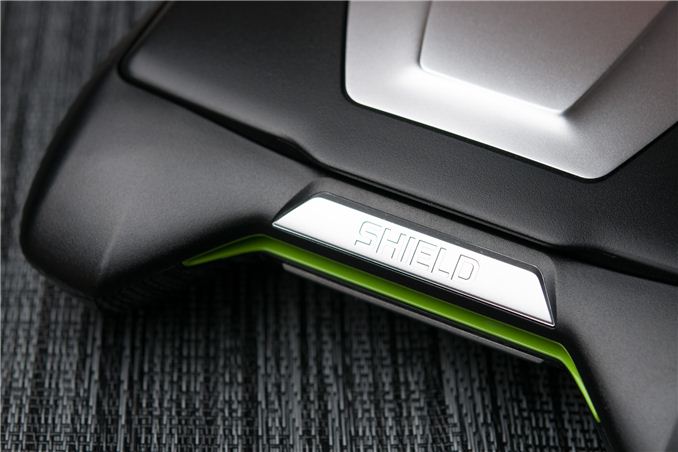
NVIDIA is doing something different with Tegra 4, very different. To bring up its silicon, each vendor usually makes a reference design phone and tablet with a selection of approved components, packages a BSP (Board Support Package), and ships that and some engineers to customers. Rather than never letting the reference design see the light of day, this time NVIDIA also made it into something they can sell directly, a portable gaming device called Shield.
It’s no secret that Tegra 4 isn’t exactly the success that NVIDIA probably hoped it would be. While the initial word was that Tegra 4 had an obvious set of design wins following momentum from products which shipped in 2012 through 2013 with Tegra 3, but it’s obvious that Shield will now effectively serve as NVIDIA’s launch vehicle for Tegra 4.
Shield is an aspirational product and not an easy one to nail down – enthusiasts are picky about controllers, Android gaming is still largely an unknown, and the question remains what presence handheld gaming consoles will have in the future. To answer all those questions NVIDIA sent over Shield, a Falcon Northwest Tiki with GTX 760 inside, and Parrot AR Drone 2.0 for us to review. Read on for the full story.
Introduction and Hardware
With Shield, NVIDIA gave us a rare glimpse into some of the stages of design. When Anand and I saw Shield at CES, it was more of a prototype than real, reviewable sample of the portable gaming device. The analog sticks weren’t weighted right, the plastic felt somewhat creaky, the triggers and bumpers felt hollow and strange, and the D-Pad worked, but not amazingly so. It was exactly what you’d expect from a prototype, and as Shield inched closer to final release the hardware got successively better and better, until the final unit dropped on our doorstep.
The hardware that is the shipping Shield today is a world better, it’s everything I was hoping Shield would end up being in terms of a controller, with the right balance and in-hand feel.
There’s so much scrutiny on the fit and finish of mobile devices these days, for NVIDIA to build a mobile device and gaming controller at the same time invites a whole new level of scrutiny, potential issues, and things to get tuned just right. I’ve purchased a few high end gaming controllers in my day (like a kitted out $125 Scuf FPS Competition Xbox 360 controller that I love), but hesitate to review them because of just how much there is to talk about, and how much of it comes down ultimately to taste.
Anand and I gave feedback to NVIDIA early on that they should arguably use the Xbox 360 controller as something of a baseline for tuning their controller components. With the Shield what we get is nearly exactly that. The analog trigger resistance, bumper clickiness, and analog stick friction feel remarkably like the 360, perhaps just a tad less. I consider the 360 controller out of the box nearly perfect, but some of that is adaption and familiarity versus being some global maxima for perfection. At the same time, if the PS3 controller is your bar, you’re probably going to have a bad time initially with Shield until you’ve adapted. Where Shield does borrow somewhat from the PS3 controller is the analog stick positioning, which is bottom center, instead of opposed top left and bottom right. One of my initial complaints was that my thumbs can collide with each other when left stick is at limits to the right, and right stick is at limits to the left (a complaint about the PS3 I have as well). NVIDIA seems to have spaced these a bit more and my thumbs aren’t quite hitting as much as they were previously.
Since the display has to close flat on the control surface, some of the shape is gated by the limitation that you can’t have the analog sticks or buttons ramming through the display, so they’re sunken down a bit. The rest of the interface (A/B/X/Y, NVIDIA, Back, Home, Start, Volume and D-Pad) rest roughly in the same plane. The spring preload on the buttons is great, though I wish they were maybe a touch less mushy for A/B/X/Y, and although I’m not much of a platform gamer, the D-Pad feels so much better now than it did before.
The shape of Shield fits in my hands really, really well. The bottom is a grippy, rubberized material that grabs the hands well and plants the Shield solidly on any surface you put it down on. The interesting shape on the back side, means I can rest my middle finger in a sort of folded position along the inside (something you can’t do with most wireless controllers) and it feels great. I have no issues with the mass of Shield fatiguing my hands or feeling awkward since it’s so well balanced and ergonomically shaped down there.
On the front of Shield is a green-tinted intake and grille for the device’s active cooling. When I first heard that Shield had active cooling I was a bit shocked, but it turns out to be completely unobtrusive in actual use.
With Shield open you can see the 5-inch 720p display surrounded by a somewhat large bezel. This remains my only complaint about Shield – I wish it had a slightly larger display that took up more of the fold-out area. Below that are stereo speakers that go loud (I love that stereo is now a feature showing up in more devices) and in the very middle is a microphone.
On the back of Shield are its I/O ports, which are microUSB 2.0, mini-HDMI, headphone jack, and microSDXC. There’s also the exhaust grille for Shield’s active cooler back here. Above the microUSB 2.0 port is a small charge status LED which is amber while plugged in and charging, and green when fully charged. I remain confused by the choice of mini-HDMI, when smartphones and tablets have universally adopted the microHDMI format plug, and I’m buried in those cables compared to a relative scarcity of mini-HDMI ones, though NVIDIA has shipped mini-HDMI GPUs before.
On the top of Shield is, well, a small shield, which NVIDIA calls a tag. This snaps onto the top and adds a bit of a customization option, it’s held in place with magnets. Out of the box the tag is a metallic silver material. It looks great but I’ve already managed to put a few hairline scratches into it, which leads me to my next point.
NVIDIA has a carrying case option available, but it really needs to give some kind of carrying case away with Shield. Although Shield feels really well constructed, right down to even the hinge mechanism, I’d like a better way to protect it, especially while traveling. I know I’m going to put more scratches into the silver tag while traveling with Shield in my bag, for example.
Shield’s in-hand feel is really, really good. NVIDIA seems to have nailed the device on the controller side, which is no small task considering this is their first attempt. As a handheld mobile device, it’s definitely on the large side, but it’s hard to really say anything negative about it since this is an entirely new form factor. Other smartphone solutions with a foldable control scheme on the phone are similarly bulky, the upside is with Shield it’s all packaged better. Again my only wishes from a purely hardware perspective would be an in-box case, bigger display, and inclusion of a front facing and rear facing camera of some kind – if nothing else for video chat and taking photos when you’ve got the Shield already in your hand.
| SHIELD (P2450A) | |
| SoC | NVIDIA Tegra 4 - 1.9 GHz |
| Display | 5-inch 1280x720 "Retinal" Display |
| RAM | 2 GB LPDDR3 |
| Wireless Connectivity | 2x2:2 802.11a/b/g/n WiFi + BT 3.0, GPS |
| Storage | 16 GB NAND total, microSD Expansion |
| I/O | microUSB 2.0, mini-HDMI, 3.5mm headphone, |
| OS | Android 4.2.1, Updates from NVIDIA |
| Battery | 28.8 Whr |
| Size / Mass | 158 x 135 x 57 mm, 579 grams |
| Buttons | Dual Analog Joysticks, D-Pad, Left/Right analog trigger and bumpers, A/B/X/Y buttons, Volume, Home, Back, Start, NVIDIA Power/Multifunction |
The hardware specs are pretty well understood at this point. There’s a Tegra 4 SoC inside working the 4 ARM Cortex A15s at up to 1.9 GHz (and one shadow core for low power), 72 GPU cores in that SoC, 2 GB of LPDDR3 RAM, 16 GB of built in flash, and 2x2:2 (yes, two stream) 802.11a/b/g/n WiFi from a BCM43241 combo which we’ve written about before.


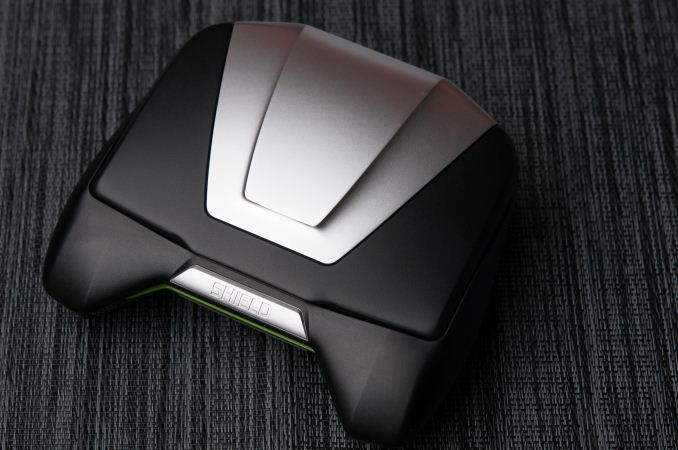
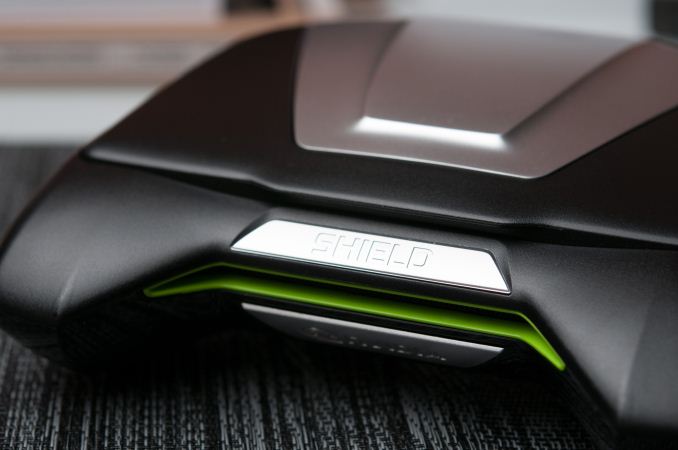


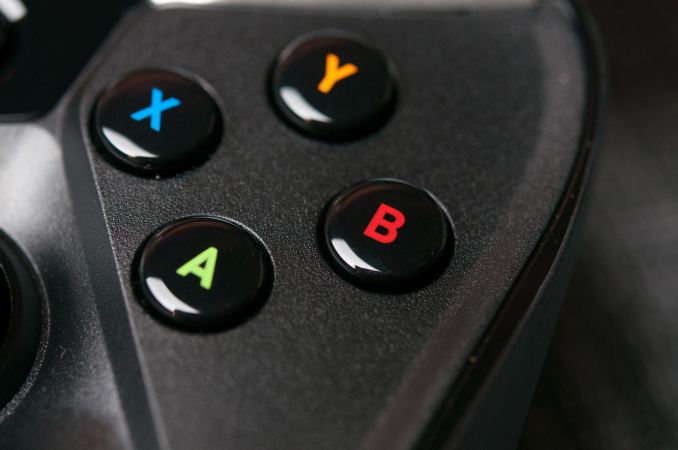
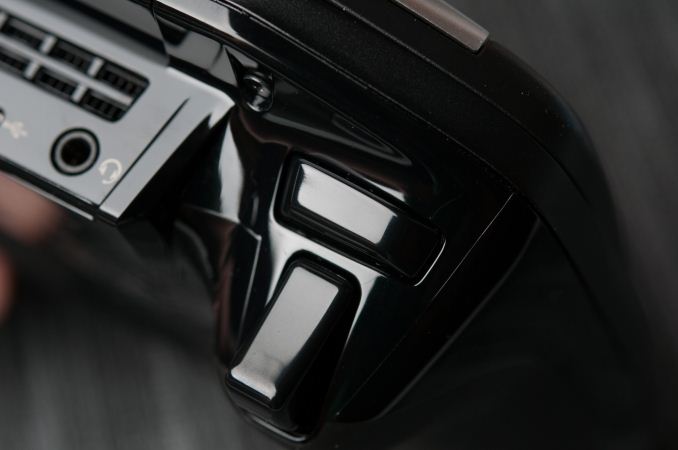
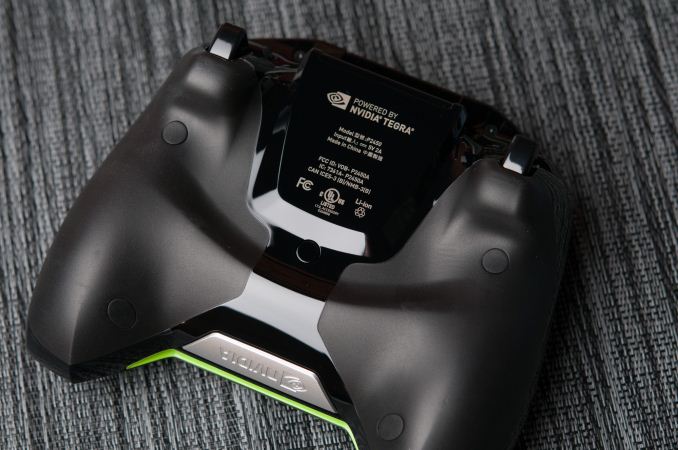
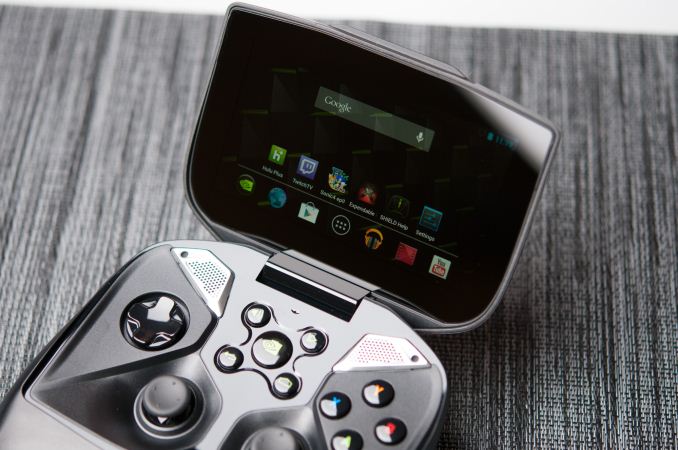
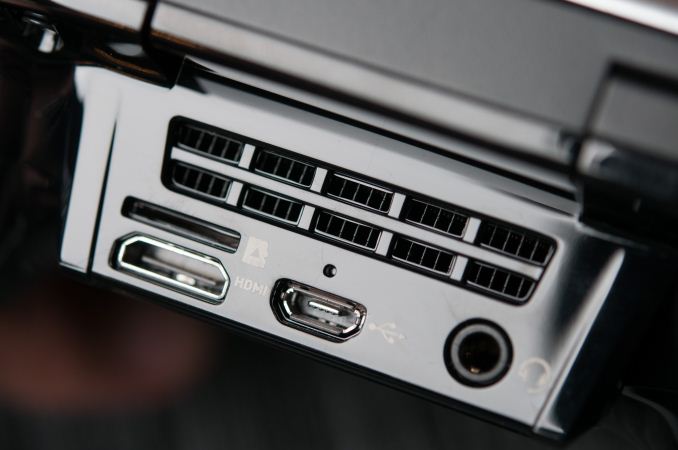
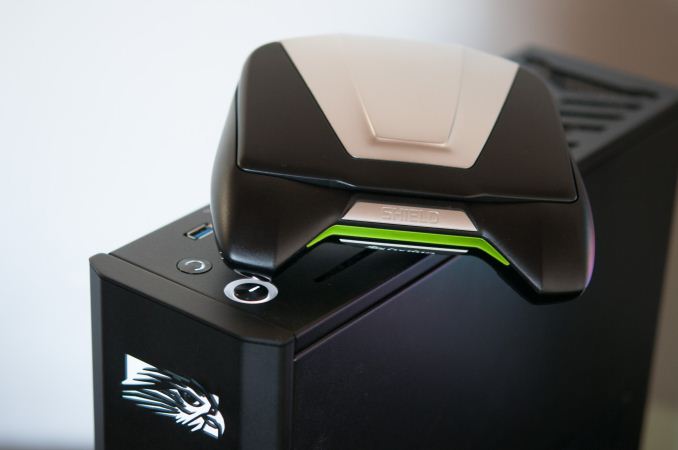














134 Comments
View All Comments
fr33h33l - Wednesday, July 31, 2013 - link
Nice review as always and good to see Shield and Tegra 4 finally shipping.I am curious though as to what has led to the (so far) low adoption rate of Tegra 4, especially in contrast to the almost performance-wise equivalent Snapdragon 800. Was it just a matter of time-to-market, or was it deal negotiation issues, or as some say (without providing conclusive evidence) that Tegra 4 is inferior to Snapdragon 800 in power efficiency?
Does anyone have more insights (as opposed to unsubstantiated rumors) into this?
Spunjji - Thursday, August 1, 2013 - link
Previously mentioned Amazon reviews for the Toshiba Excite Pro indicate overheating issues and poor battery life. That's not as good as a proper analysis but I'd hesitate to call it unsubstantiated.fteoath64 - Saturday, August 3, 2013 - link
A lot of people are curious about this same question :"Is Tegra 4 is inferior to Snapdragon 800 in power efficiency?". I would agree that it is a yes but not by much. The issue for both chips are that they are overkill (in battery sapping rate) for phone implementation and more suitable for large tablet and console use such as Shield. I think the issue of T4 is its TTM just kills the market opportunity and also the fact that Qualcomm has had multiple solutions to match/counter the old T3 design wins and hence snags them all!. It is a pity for Nvidia but the market is rather brutal due to fierce competition. Even Intel cannot muscle themselves in with the new Atom chip. Not that it is good enough or low priced (huh!). This T4 device at least gives the market some sort of benchmark in comparing its performance in detail over the coming weeks. The S800 tablets are not as forthcoming as we hoped so there is plenty of time to determine some much wanted data.It is interesting to see the SnapDragon S4 Pro chip being used in Nexus 7 and Moto X, new Droid range as well especially when the flagship S600 was doing so well. Is there a radical price difference , I wonder ...
WeaselITB - Wednesday, July 31, 2013 - link
Didn't see it in the review, but I'm curious how well it performs streaming PC game to Shield to HDMI cable plugged into a TV. Cabling get in the way? Problems with battery life in this scenario? How well does the high-res PC compress down to stream to the Shield, then upconvert back to 1080p for the TV? What about transition from sitting on the couch with the cable plugged into the TV, then unplugging the cable to walk into the kitchen, any glitches with transitioning back to the in-device screen?marraco - Wednesday, July 31, 2013 - link
I wish I had a PC client for streaming, so I can run my GTX 670 and play on my laptop/netbookmarraco - Wednesday, July 31, 2013 - link
That would rule out AMD cards for mepandemonium - Thursday, August 1, 2013 - link
I just don't see the point in spending money on a mobile gaming device any more. With all of the smartphones and tablets out there, this is going to be a difficult sell to anyone but the most enthusiastic of fans.Also, my PC is built for gaming and the ecosystem isn't really going anywhere (contrary to popular belief that it's been dying for years and years...). Plus, there's consoles.
It may be awesome, but not for the current day and age. If this came out in 2006, it would've made a killing.
darkhawk1980 - Thursday, August 1, 2013 - link
The only comment I have is that when I played around with this at PAX East 2013, the screen mechanism felt VERY flimsy. I'm not sure if it was because of the fact that these were demo units that were (obviously) very used at that point or what, but I felt like if I closed the screen the hinge would make the screen break in half. It just didn't provide a good feel as it closed, like the hinge was too tight. It reminded me of my MSI GT70's screen at times, where I'm very careful closing it since it is rather delicate.All that aside, it did seem like a good device and was fun to use, but I just don't feel I'd use it as much simply because I enjoy having a tablet for real use.
bertiebond - Thursday, August 1, 2013 - link
so.. its got a screen, it has speakers, it has a a mic, it has wifi..so it just needs 3g and you can stick it next to your ear and start making calls ?D
Spunjji - Thursday, August 1, 2013 - link
SIDETALKIN'